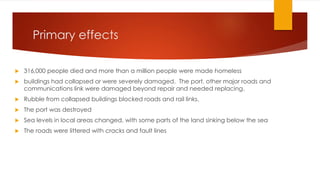the devastating Haiti earthquake
- 1. Haiti earthquake Bi Rhys Thomas
- 2. GENERAL FACTS A catastrophic magnitude 7.0 M earthquake, with an epicentre near the town of Léogâne approximately 25 kilometres (16 mi) west of Port-au-Prince, Haiti's capital. The earthquake occurred at 16:53 local time on Tuesday, 12 January 2010 . By 24 January, at least 52 aftershocks measuring 4.5 or greater had been recorded. An estimated three million people were affected by the quake. Death estimates range from 100,000 to 220 000.
- 3. Primary effects 316,000 people died and more than a million people were made homeless buildings had collapsed or were severely damaged. The port, other major roads and communications link were damaged beyond repair and needed replacing. Rubble from collapsed buildings blocked roads and rail links. The port was destroyed Sea levels in local areas changed, with some parts of the land sinking below the sea The roads were littered with cracks and fault lines
- 4. Primary responses Many countries responded to appeals for aid, pledging funds and dispatching rescue and medical teams, engineers and support personnel. Communication systems, air, land, and sea transport facilities, hospitals, and electrical networks had been damaged by the earthquake, which slowed rescue and aid efforts. There was much confusion over who was in charge, air traffic congestion, and problems with prioritisation of flights further complicated early relief work. Port-au-Prince's morgues were quickly overwhelmed with many tens of thousands of bodies having to be buried in mass graves. As rescues tailed off, supplies, medical care and sanitation became priorities. Delays in aid distribution led to angry appeals from aid workers and survivors, and looting and sporadic violence were observed.
- 5. Secondary effects The secondary effects of the Haiti earthquake were the lack of food, homelessness, there was landslides, liquidation, in which the land turned into the consistency of jam and there was a cholera outburst because of the lack of clean water. There was a massive clean-up operation and many people lost everything which resulted in theft, drug dealing and other crimes. People took the water aid money. The tourist industry declined as tourists stopped visiting.
- 6. SECONDARY SOLUTIONS • MONEY WAS PLEDGED BY ORGANISATIONS AND GOVERNMENTS TO ASSIST IN REBUILDING, BUT ONLY SLOW PROGRESS HAD BEEN MADE AFTER ONE YEAR. • AFTER ONE YEAR, THERE WERE STILL 1,300 CAMPS. • ‘CASH FOR WORK’ PROGRAMS ARE PAYING HAITIANS TO CLEAR RUBBLE. • SMALL FARMERS ARE BEING SUPPORTED – SO CROPS CAN BE GROWN. • SCHOOLS ARE BEING REBUILT.
- 7. MAP
- 8. •THANK YOU FOR LISTENING.








